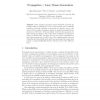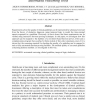115 search results - page 21 / 23 » Representing First-Order Causal Theories by Logic Programs |
CMOT
1998
13 years 5 months ago
1998
A programming language which is optimized for modelling multi-agent interaction within articulated social structures such as organizations is described with several examples of it...
FASE
2009
Springer
13 years 9 months ago
2009
Springer
This paper describes the certification of smart-card applications in the framework of Common Criteria. In this framework, a smart-card application is represented by a model of its...
CP
2007
Springer
14 years 4 days ago
2007
Springer
Finite domain propagation solvers effectively represent the possible values of variables by a set of choices which can be naturally modelled as Boolean variables. In this paper we...
CORR
2008
Springer
13 years 6 months ago
2008
Springer
Requirements about the quality of clinical guidelines can be represented by schemata borrowed from the theory of abductive diagnosis, using temporal logic to model the time-orient...
POPL
2007
ACM
14 years 6 months ago
2007
ACM
This paper is concerned with a programming language construct for typed name binding that enforces -equivalence. It proves a new result about what operations on names can co-exist...


